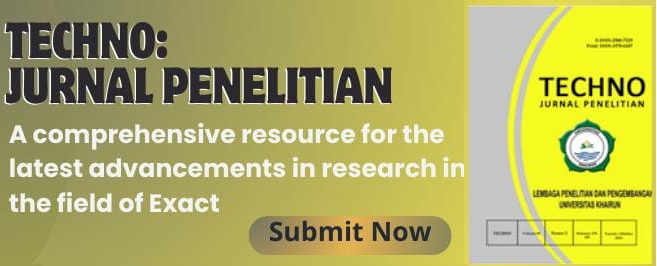Earthquake Disaster Risk Assessment Analysis In Jailolo Coastal Region
Abstract
The village, which is located in the Coastal District of Jailolo, West Halmahera, had a considerable impact from the earthquake. This is because the earthquakes that occur are influenced by tectonic earthquakes due to the movement and collision of tectonic plates on land and the seabed. If the collision causes a fault in the seabed, a tsunami can occur. The purpose of this study was to analyze the risk of earthquake disasters in supporting development planning and to produce an earthquake risk map for the coastal area of Jailolo District, West Halmahera. The analytical method used is descriptive quantitative, and the data collection model is a questionnaire with random sampling. The results obtained are in the form of a hazard value using the PGA value and produce the same PGA value, namely > 0.70 gal with a high category for Bobanehena Village, Saria Village, Payo Village, Bobo Village, and Idamdehe Village. The value of vulnerability (physical, social, and economic vulnerability) shows that Bobanehena Village has a high vulnerability index value with a score of 1.9. The capacity index value for the five villages has the same score of 3 and is included in the high class. So that the value of the earthquake risk level with a high class is obtained, namely in Bobanehena Village and Bobo Village. The high level of risk in the two villages is influenced by the frequency of occurrence of earthquakes with high intensity in the area, the impact of losses due to earthquakes is quite high. Earthquake risk reduction efforts will be maximized if a comprehensive earthquake risk assessment analysis is carried out and a commitment from the Government is carried out.
Keywords
Full Text:
PDFReferences
Amri, M. R., Yulianti, G., Yunus, R., Wiguna, S., Adi, A. W., Ichwana, A. N., ... & Septian, R. T. (2016). Risiko Bencana Indonesia. Jakarta: Badan Nasional Penanggulangan Bencana.
BNPB. (2015). Badan Penanggulangan Resiko Bencana Kajian Risiko Bencana Maluku Utara 2016 - 2020. Jakarta: Badan Nasional Penanggulangan Bencana
Christianto, J. (2011). Gempa Bumi, Kerusakan Lingkungan, Kebijakan dan Strategi Pengelolaan. Yogyakarta: Liberty Yogyakarta.
Desmonda, N. I., & Pamungkas, A. (2014). Penentuan Zona Kerentanan Bencana Gempa Bumi Tektonik di Kabupaten Malang Wilayah Selatan. Jurnal Teknik ITS, 3(2), 107-112. http://dx.doi.org/10.12962/j23373539.v3i2.7232
Dewi, C., Armijon, & Fadly, R. (2014). Analisis Pembuatan Peta Zona Rawan Bencana Tsunami Pada Daerah Pesisir (Studi Lokasi: Pesisir Kota Bandar Lampung). In Prosiding Sembistek 2014, 1(02), 740-753.
Dixit, A. M., Yatabe, R., Dahal, R. K., & Bhandary, N. P. (2013). Initiatives for Earthquake Disaster Risk Management in The Kathmandu Valley. Natural Hazards, 69(1), 631-654. https://doi.org/10.1007/s11069-013-0732-9
Habibi, M., & Buchori, I. (2013). Model Spasial Kerentanan Sosial Ekonomi dan Kelembagaan Terhadap Bencana Gunung Merapi. Teknik PWK (Perencanaan Wilayah Kota), 2(1), 1-10.
Husein, A., & Onasis, A. (2017). Menajemen Bencana. Jakarta: Pusat Pendidikan Sumber Daya Manusia Kesehatan.
Korkmaz, K. A. (2009). Earthquake Disaster Risk Assessment and Evaluation For Turkey. Environmental Geology, 57(2), 307-320. https://doi.org/10.1007/s00254-008-1439-1
Murtianto, H. (2016). Potensi Kerusakan Gempa Bumi Akibat Pergerakan Patahan Sumatera di Sumatera Barat dan Sekitarnya. Jurnal Geografi Gea, 10(1), 80-86. https://doi.org/10.17509/gea.v10i1.1667.g1126
Motiram, B. H. (2014). Earthquake Risk Assessment, Loss Estimation and Vulnerability Mapping for Dehradun City, India. University of Twente, Enschede, The Netherlands.
Ningrum, R. W., Suryanto, W., Fauzi, H., & Mei, E. T. W. Mapping of PGA Value Using PSA Method in West Halmahera Nort Maluku. Jurnal Teknosains, 9(2), 116-126. https://doi.org/10.22146/teknosains.41483
Nurmaya, A., Setiawan, M. A., & Purwanto, T. H. (2019). Dinamika Spasial dan Temporal Kerentanan Sosial Terhadap Dampak Bencana Gempa Bumi Studi Kasus: Dusun Jogo. Majalah Ilmiah Globe, 21(2), 71-78. http://dx.doi.org/10.24895/MIG.2019.21-2.915
Pratiwi, D., & Fitri, A. (2021). Analisis Potensial Penjalaran Gelombang Tsunami di Pesisir Barat Lampung, Indonesia. Jurnal Teknik Sipil, 8(1), 29-37. https://doi.org/10.21063/JTS.2021.V801.05
Rahmawati, N. I., Santosa, B. J., Setyonegoro, W., & Sunardi, B. (2017). “Pemodelan Tsunami di Sekitar Laut Banda dan Implikasi Inundasi di Daerah Terdampak. Jurnal Sains dan Seni ITS, 6(2), 33–36. http://dx.doi.org/10.12962/j23373520.v6i2.25864
Toyfur, M. F. (2015). Indicators Identification for Developing Earthquake Risk Disaster Model for Roads. In International Conference on Coastal and Delta Areas (Vol. 1, No. 1, pp. 219-225).
DOI: https://doi.org/10.33387/tjp.v10i2.3523
Refbacks
- There are currently no refbacks.
Copyright (c) 2022 Rohima Wahyu Ningrum, Risky Nuri Amelia, Hasmawati Hasmawati, Marwis Aswan

This work is licensed under a Creative Commons Attribution-NonCommercial 4.0 International License.
-------------------------------------------------------------------------------------------------------------------------------------------------------------------
-------------------------------------------------------------------------------------------------------------------------------------------------------------------
TECHNO: Jurnal Penelitian
Published by: LPPM Universitas Khairun
Addres : Jalan Yusuf Abdurrahman Kampus II Unkhair, Kelurahan Gambesi, 97722 Kecamatan Kota Ternate Selatan, Provinsi Maluku Utara, Email: techno@unkhair.ac.id | URL: http://ejournal.unkhair.ac.id/index.php/Techno
Techno Jurnal Penelitian is licensed under a Creative Commons Attribution-NonCommercial 4.0 International License.


























